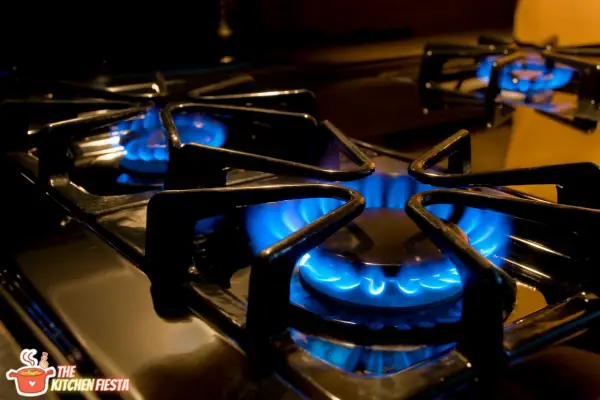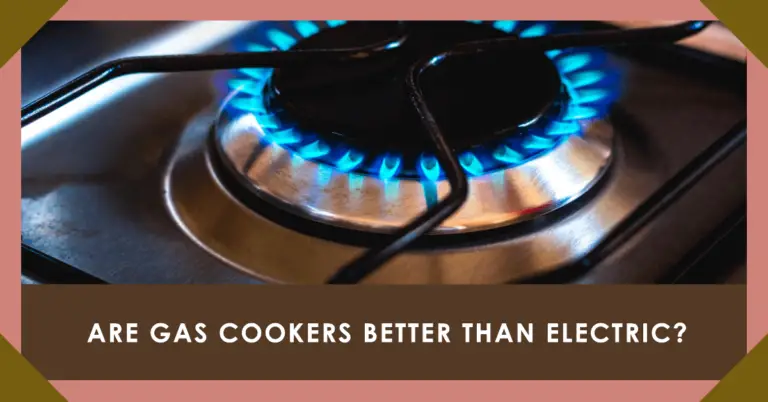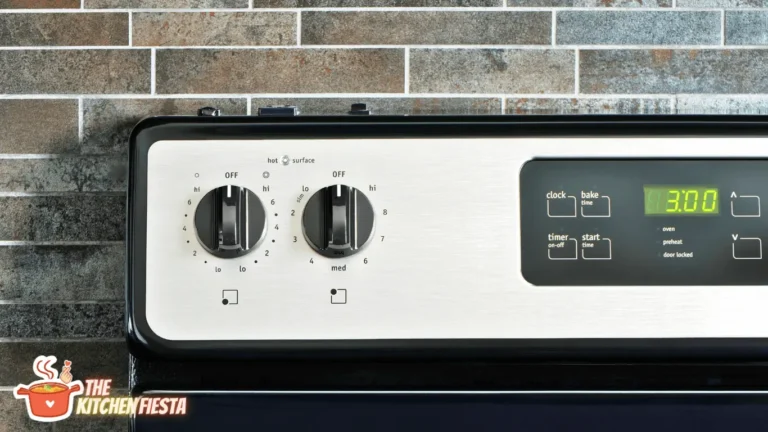Do Electric Stoves Use Gas? Surprising Answer + Electric vs Gas Stove Comparison

When shopping for a new stove, one of the first decisions you’ll make is whether to get an electric stove or a gas stove. But if you’re unfamiliar with how stoves work, you may be wondering – do electric stoves use gas?
The short answer is no, electric stoves do not use any type of gas like natural gas or propane. Electric stoves operate entirely on electricity and utilize metal heating elements, while gas stoves rely on natural gas lines to produce flames for cooking.
In this detailed guide, we’ll cover everything you need to know about the differences between electric and gas stoves, including:
- How each type of stove works
- Key differences in heating methods, heat control, speed, safety and costs
- Cooking performance comparisons for heating power, temperature control, techniques and oven performance
- Cost comparisons including purchase price, installation, operating costs and maintenance
- The pros and cons of electric vs gas to determine which is better for most homes
Let’s start by looking at the basic principles of how electric and gas stoves work.
How Do Electric and Gas Stoves Work?
Electric and gas stoves operate on completely different principles. Understanding these differences will help explain their varying performance for cooking.

What Powers an Electric Stove?
Electric stoves utilize electricity to power their burners and ovens. Instead of any type of fuel, they use metal heating elements that generate heat when electric current passes through them.
The stovetop of an electric range contains circular coil heating elements or flat, smooth elements that heat up when electricity runs through them. Underneath, there is wiring that connects the elements to the electrical supply. The heating elements transfer this heat to pots and pans placed on the cooktop.
Inside an electric oven, there is also a heating element at the bottom which heats up and spreads warmth throughout the oven cavity. Additional heating elements may be located at the top and sides of the oven to distribute heat more evenly. The oven thermostat controls the temperature by regulating electricity to the heating elements.
What Powers a Gas Stove?

Gas stoves operate quite differently from electric models. Instead of using electricity for heat, they utilize natural gas provided by gas lines installed in the home.
The burners on top of a gas cooktop have gas valves that control the amount of gas released. When the valve is turned on, gas flows out and is ignited by an electric spark, producing a flame. This open flame then provides the heat that is transferred to cookware on the stove.
Inside a gas oven, there is a gas burner that ignites to produce a flame that spreads warmth. The oven burner may also heat up a convection fan that helps circulate hot air. Gas ovens regulate the size of the flame to control the temperature.
Do Electric Stoves Use Any Gas?
To summarize, electric stoves operate entirely on electricity and do not utilize any form of combustible gas like natural gas, propane or butane. They do not require any gas lines or external gas source. The heat is generated internally through their electric heating elements.
So the answer is no – electric stoves do not use any gas whatsoever. They are powered solely by electricity.
Now that we’ve covered the basic functioning of electric and gas stoves, let’s look at some of the key differences between the two types.
Key Differences Between Electric and Gas Stoves
While electric and gas stoves both aim to accomplish the same goal of cooking food, their designs and heating methods lead to a number of differences that impact their performance, installation, and other factors.
Heating Method
The most fundamental difference between electric and gas stoves is how they produce heat:
- Electric stoves use metal heating elements that generate heat when electric current passes through them.
- Gas stoves utilize an external supply of natural gas to produce an open flame that provides heat.
This contrast in heating methods has implications for how controllable, responsive, and consistent the heat output can be.
Heat Control
The way heat is controlled also differs:
- On an electric stove, the heat is adjusted by increasing or decreasing the electric current flowing to the heating elements. This allows quite precise regulation of the heat.
- On a gas stove, heat is controlled by adjusting the size of the gas flame. This does not offer as precise control compared to electric elements.
Heating Speed
There is also a difference in how quickly electric and gas stoves can change temperature:
- Electric elements take longer to heat up from cold and longer to cool back down after use.
- The open flames used by gas stoves provide near instantaneous heating but also cool down quickly when turned off.
This makes gas burners quicker to heat and faster to adjust, while electric elements maintain a consistent temp longer.
Safety
The different heat sources lead to varying safety considerations:
- Electric stoves avoid the risks associated with open flames and combustible gases.
- Gas stoves have a slight safety risk due to potential gas leaks, fires or explosions if not properly installed or maintained.
So electric stoves provide a level of safety by completely avoiding use of flammable gas.
Costs
There are also cost differences between the two types:
- Electric stoves tend to have lower operating costs, since electricity prices are fairly stable.
- Gas stoves incur higher ongoing costs because the price of natural gas can fluctuate.
- Installation also costs more for gas stoves since gas lines must be run and proper ventilation installed.
We’ll break these costs down in more detail later. First, let’s compare how electric and gas stoves perform for cooking.
Cooking Performance Comparison
Beyond just the technical differences in how they operate, electric and gas stoves each have pros and cons when it comes to actual cooking ability. We’ll look at heating power, temperature control, cooking techniques, and oven performance.
Heating Power
One of the main advantages of gas stoves is the level of heating power they can achieve:
- The burners on gas cooktops can produce more heat at maximum flame than standard electric elements.
- This allows gas stoves to reach higher maximum temperatures for searing, frying, boiling water rapidly, etc.
However, for moderate cooking tasks, there is less noticeable difference:
- At lower heat settings, standard electric elements can provide sufficient heating capacity for most cooking jobs.
- High-powered induction or dual elements on electric stoves can match the highest heat output of gas.
For oven performance, electric stoves have an advantage:
- Electric ovens tend to heat more evenly and consistently at lower temperatures than gas ovens.
- At very high temps, gas ovens may have a slight edge in heating power.
So for the oven, electric stoves often maintain temperatures better, while gas stovetops allow higher maximum heat.
Temperature Control
Another contrast is in the responsiveness and fine control of temperatures:
- The instant heat adjustment of gas burners makes it easy to quickly raise or lower the cooking temperature as needed.
- Electric elements don’t allow as quick of temp changes, but maintain a consistent heat without fluctuation.
The open flame of gas makes it more responsive, while electric elements provide stable precision heating.
Cooking Techniques
The quick heating of gas lends itself well to certain cooking techniques:
- Gas stoves excel at high-heat fast cooking methods like stir-frying, boiling water rapidly, searing meats, etc.
- Their quick temperature adjustments also helps with delicate cooking tasks.
Meanwhile, the steady heat of electric stoves suits other techniques:
- Electric stoves work well for simmering at low temperatures, holding a stable temp for a long time, cooking casseroles, and any slow cooking recipes.
- Their even, consistent heat also makes them ideal for baking cakes, cookies, and breads.
So for quick high-heat cooking, gas often works best. But for low, steady heat electric stoves perform excellently.
Oven Performance
Gas and electric ovens also have differences that make them each better suited to certain tasks:
- Gas ovens provide more humidity within the oven, which is beneficial when cooking meats, stews or breads.
- Electric ovens maintain an extremely even, consistent temperature throughout, making them ideal for baking.
The humidity in gas ovens lends well to roasting meats or baking artisan breads. But for delicate cookies, cakes, soufflés, etc. an electric oven provides the precision heating needed.
So in summary, gas stoves offer more heating power and quick adjustment of temps, while electric stoves provide consistent precision heating better suited for baking.
Now let’s compare the costs of purchasing and operating both types of stoves over their lifespan.
Costs of Electric vs. Gas Stoves
One of the key factors in choosing between an electric or gas stove is the differences in upfront costs, operating expenses, maintenance needs, and installation requirements.
Purchase Price
For most standard home models, electric and gas stoves have very comparable purchase prices:
- Basic to mid-range electric and gas stoves cost about the same – typically $500 to $1,500.
- Commercial-grade or ultra high-end gas stoves do usually cost slightly more than their electric counterparts.
But for most residential purchases, expect to pay around the same whether you choose electric or gas.
Installation Cost
However, there is a significant difference in installation costs:
- Connecting an electric stove just requires plugging it into an existing 240-volt outlet. Very minimal install cost.
- Gas stoves need to have gas supply lines run from the main gas line to the kitchen, as well as proper ventilation installed. This adds a substantial installation expense.
If your home does not have an existing gas line to the kitchen, the cost to install one can add $300-$800 or more to have gas service brought to the stove.
Operating Costs
Over the lifespan of your stove, operating costs are impacted by whether you choose electric or gas:
- Electric stoves have lower operating costs, since electricity prices tend to remain fairly stable over time.
- Gas stoves have higher operational costs because natural gas prices can fluctuate year-to-year.
Based on current energy prices in the U.S., an electric stove costs around $35-$45 per year to operate. A gas stove with typical usage costs $40-$60 annually for the gas required to fuel it.
So electric stoves save at least a little on annual usage costs, and potentiall much more if gas prices rise.
Maintenance and Repairs
Routine maintenance and repairs over the lifespan of a stove are also a cost consideration:
- Electric stoves tend to have fewer moving parts that can break down and typically need fewer repairs than gas models.
- Gas stoves require more periodic maintenance to keep burners and gas lines operating safely, and repairs are more likely over time.
While repairs for both types of stoves average $200-$350, gas stove repairs may be required more frequently due to the additional components involved.
To summarize, while electric and gas stoves have similar upfront prices, gas stoves cost more for installation, annual operating costs, and long-term repairs.
Now that we’ve compared technical differences and costs, let’s look at the key pros and cons of electric vs gas stoves.
Which Is Better – Electric or Gas Stove?
So when considering all of these comparisons between electric and gas stoves, which type of range is right for most kitchens? Here is an overview of the relative benefits of each:
Benefits of Electric Stoves:
- Provide very precise and stable temperature control
- Heat consistently and evenly, ideal for baking use
- Carry lower operating costs over their lifespan
- Are simple to install without need for gas lines
- Avoid the fire and explosion risks of gas appliances
Benefits of Gas Stoves:
- Offer faster heating, cooling and temp adjustments
- Provide very high heat output for wok cooking, searing, etc.
- Their oven humidity is beneficial for roasts and breads
- Open gas flames provide visible cooking cues
- Quick heat responsiveness good for delicate cooking
Best for Most Home Cooks:
Taking all of these factors together, for most household cooking purposes an electric stove is generally the better choice. Here’s why:
- The precise baking heat and lack of open flame make electric stoves safer and easier to use for average cooking needs.
- Electric stoves are less expensive to install and operate, providing cost savings over their lifespan.
- They heat adequately for the majority of family meals and recipes.
Gas stoves can provide some advantages for very high heat tasks like frying, searing, or boiling. But for all-around family cooking, baking, and ease of use, electric stoves are ideal for most homes.
Modern induction electric stoves also bridge the gap in power and controllability compared to gas. So technology advancements continue to make electric models preferable for the majority of buyers.
Conclusion
To answer our original question – no, electric stoves do not use any gas in their operation. They utilize only electricity and metal heating elements to generate heat for cooking.
While gas stoves provide some benefits for their quick, high heat output, electric stoves are generally easier and more affordable to operate and install, provide precise baking temperatures, and avoid the risks of open flames.
For most household cooking needs, electric ranges are typically the better choice for reliability, safety, cost-efficiency, and all-around performance. Carefully considering the differences in how they function and comparing real cooking tests can help identify which type of stove suits your cooking style and needs best. But for most buyers, the numerous advantages of electric stoves make them the ideal choice for equipping their kitchen.






